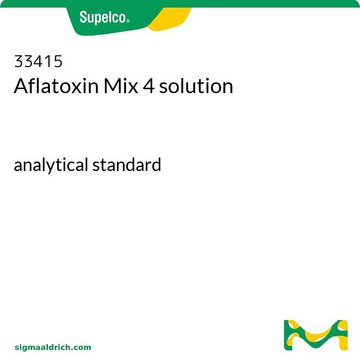Kluczowe dokumenty
ERMAC059
Aflatoxin G1 solution
3.78 μg/g in acetonitrile, ERM®, certified reference material
About This Item
Polecane produkty
klasa czystości
certified reference material
agency
ERM®
producent / nazwa handlowa
JRC
stężenie
3.78 μg/g in acetonitrile
Zastosowanie
general analytical
format
single component solution
temp. przechowywania
2-8°C
ciąg SMILES
COc1cc2OC3OC=CC3c2c4OC(=O)C5=C(CCOC5=O)c14
InChI
1S/C17H12O7/c1-20-9-6-10-12(8-3-5-22-17(8)23-10)14-11(9)7-2-4-21-15(18)13(7)16(19)24-14/h3,5-6,8,17H,2,4H2,1H3
Klucz InChI
XWIYFDMXXLINPU-UHFFFAOYSA-N
Szukasz podobnych produktów? Odwiedź Przewodnik dotyczący porównywania produktów
Komentarz do analizy
ERMAC059
Informacje prawne
produkt powiązany
Hasło ostrzegawcze
Danger
Zwroty wskazujące rodzaj zagrożenia
Zwroty wskazujące środki ostrożności
Klasyfikacja zagrożeń
Acute Tox. 4 Dermal - Acute Tox. 4 Inhalation - Acute Tox. 4 Oral - Eye Irrit. 2 - Flam. Liq. 2
Kod klasy składowania
3 - Flammable liquids
Klasa zagrożenia wodnego (WGK)
WGK 2
Temperatura zapłonu (°F)
35.6 °F - closed cup
Temperatura zapłonu (°C)
2.0 °C - closed cup
Wybierz jedną z najnowszych wersji:
Certyfikaty analizy (CoA)
Przepraszamy, ale COA dla tego produktu nie jest aktualnie dostępny online.
Proszę o kontakt, jeśli potrzebna jest pomoc Obsługa Klienta
Masz już ten produkt?
Dokumenty związane z niedawno zakupionymi produktami zostały zamieszczone w Bibliotece dokumentów.
Klienci oglądali również te produkty
Nasz zespół naukowców ma doświadczenie we wszystkich obszarach badań, w tym w naukach przyrodniczych, materiałoznawstwie, syntezie chemicznej, chromatografii, analityce i wielu innych dziedzinach.
Skontaktuj się z zespołem ds. pomocy technicznej


